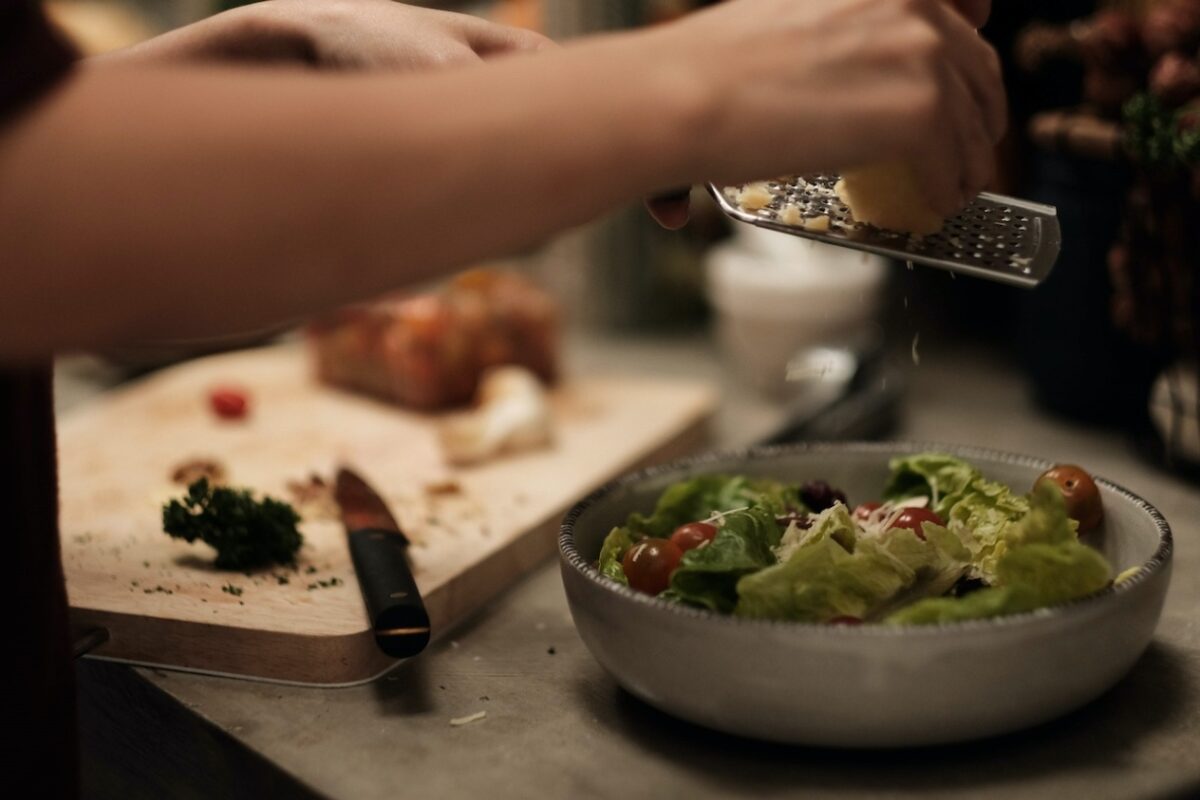

Preparing your own meals can help you take charge of your health. Here’s how to cook tasty, nutritious food for one person.

Today, more and more of us live alone, either through choice or circumstances. As a single person, finding the motivation to cook for yourself can be difficult, especially after a long day at work. Coming up with meal ideas and finding recipes for one person can seem like a chore, even if you know how to cook and have a full kitchen at your disposal.
Eating out, hitting the drive-through, or throwing a frozen dinner in the microwave can seem like a much easier option. But regularly eating convenience food can take a toll on your physical and mental health, as well as your waistline.
Fast food and TV dinners tend to be low in nutrition and high in unhealthy fat, sugar, sodium, and calories. Often, for less money and only a little more time, you can create healthier, better tasting meals yourself.
The key to cooking for one is to master a few basic skills, stock up on essential ingredients, and get creative in making meals that work specifically for you. Even if you live in a dorm room, bachelor apartment, or other accommodation without a full kitchen, you can learn to cook quick, inexpensive meals that not only taste great but also boost your energy, stabilize your mood, and keep you as healthy as possible.
One of the easiest ways to improve your mental and physical health is by preparing more meals at home. Cooking for yourself gives you greater control over the ingredients in your meals, enabling you to cut down on the additives and calories often loaded into takeout and convenience food. Improving your diet with simple, healthy home-cooked meals can also help you lower your risk for serious illness, boost your energy, sharpen your mind, lose weight, and improve how you manage stress, anxiety and depression.
While all this remains true of cooking at home for an entire family, there are also specific benefits of cooking just for yourself:
You can eat whatever you want, whenever you want. The great thing about cooking for one is that you don’t have to please anyone but yourself. Cook using the ingredients you enjoy, even if they’re not to other people’s liking, or have breakfast for dinner if that’s what you feel like.
Meals can be cooked faster. Cooking a single serving meal is often quicker than cooking enough for four or more people.
There’s less waste and less cleanup. You don’t have to cater for anyone else’s taste, so food won’t go uneaten. And when you cook a one-pot meal, for example, you can eat it directly from the pot, cutting down on cleanup after.
It can save you money. Cooking at home tends to cost less than eating takeout or restaurant food. Being a smart shopper can enable you to find healthy food for less. And since you’re only cooking for yourself, you may be able to occasionally splurge on more expensive ingredients, such as organic meat or produce.
It’s empowering. Taking charge of your diet and spending time caring for yourself can improve your mood and self-esteem—as well as your overall health.
For some single people, cooking for yourself just means having to spend more time alone. You may choose to regularly eat out—even if it just involves sitting alone in a fast food restaurant—to feel a connection to other people. Eating out means you’re more likely to meet new people, strike up a conversation with a stranger, or at least break the monotony of another evening alone. However, cooking for yourself doesn’t have to mean eating alone. With some creativity, you can cook healthy, inexpensive meals at home, and still find that connection to others that we all need.
Dinner doesn’t have to mean a traditional meal of protein, starch, and vegetables. In fact, when you’re cooking just for yourself, dinner doesn’t have to mean dinner at all. A breakfast of omelet, cheese, and veggies can also work as a healthy evening meal. Mix things up and cook using whatever combination of healthy ingredients you enjoy.
Cooking for one doesn’t have to involve a huge investment of time, either. A microwaved baked potato, filled with cheese or canned tuna, and served with steamed vegetables or a salad, for example, makes a healthy, balanced meal that’s ready in minutes.
Stock up on staples. Keeping your cupboards stocked with a small number of staple ingredients means you’ll always be able to whip up a healthy meal quickly and easily. These include items such as canned tomatoes, beans, and tuna, frozen fruit and vegetables, dried herbs and spices, nuts, oil, vinegar, bouillon cubes, pasta, rice, and flour.
Look for shortcuts. Buying pre-chopped and washed vegetables and salads can save time on meal preparation and cleanup.
Cook once, eat multiple times. Sure, you can take a family-size recipe and divide everything by four or six to make a meal for one person. Or you can cook larger meals and freeze leftovers in single portions to eat another time.
Prepare meals without cooking. Making your own meals doesn’t always have to involve any cooking at all. As well as eating raw veggies and salads, try uncooked probiotic foods—those containing “good” bacteria, such as yogurt, sauerkraut, soft cheese, or vegetables pickled in brine—for quick and healthy snacks or side dishes.
Cook your main protein once a week. By roasting a chicken on the weekend or slow cooking a turkey breast, for example, you can use the leftover meat to quickly create different dishes during the week. Add the meat to a soup or salad, slice it in sandwiches, use in tacos, quesadillas, or burritos, or combine with veggies and add to pasta or rice.
Reinvent leftovers. If you don’t want to eat the same meal a second time, having leftovers can be a great starting place for your next meal. For example, wrap leftover chicken, rice, and veggies in a tortilla, then add a little cheese and salsa—and you have a whole new meal.
You don’t have to be perfect. Don’t think that you have to start off by making every meal at home in order to reap the health benefits. Like anything, cooking for yourself is a habit that develops over time. Preparing home-cooked meals just a few times a week can improve how well you think and feel and encourage you to cook more often.
BetterHelp is an online therapy service that matches you to licensed, accredited therapists who can help with depression, anxiety, relationships, and more. Take the assessment and get matched with a therapist in as little as 48 hours.
Take Assessment HelpGuide is user supported. We earn a commission if you sign up for BetterHelp’s services after clicking through from this site. Learn moreIf you live in a dorm room, bachelor apartment, hotel room, or another location without a full kitchen, cooking for yourself can be more challenging—but it’s certainly not impossible. Even if you have access to a full kitchen, space-saving appliances such as a slow cooker, steamer, or toaster oven can be quick and easy to use, especially if you’re a novice cook.
A slow cooker or crock-pot is a plug-in device that slowly cooks food on a counter or table. It’s designed to cook unattended so you can add ingredients in the morning before work and then come home at the end of the day to a fully cooked meal.
Toaster oven. Because it heats quickly, a toaster oven is an economical way to broil, bake, and roast vegetables, or make toasted sandwiches.
Air fryer. An air fryer uses hot air to quickly and easily brown and crisp food. It’s much healthier than deep frying in oil, and can be used to cook many different recipes, including proteins, vegetables, and frozen foods. It can also be a good option to reheat leftovers instead of a microwave.
Hot plate. Ideal for hotel rooms, dorm rooms, and small apartments. Just about anything that can be made on a stove top can be made on a hot plate with a saucepan or frying pan.
Rice cooker. With a little creativity, it can also be used to cook flavorful one-pot dishes as well as rice.
Steamer. Steaming is the one of the quickest and healthiest ways to prepare food. You can use a standalone electronic steamer or a steamer basket that fits into a saucepan.
If you don’t have a fridge, shop for food in individual servings or small packages. While these can be more expensive, you’ll likely have less waste from spoilage, so they can ultimately be more cost effective.
The amount of time that food stays fresh without refrigeration varies:
Millions of readers rely on HelpGuide.org for free, evidence-based resources to understand and navigate mental health challenges. Please donate today to help us save, support, and change lives.
Donate to HelpGuide.org today